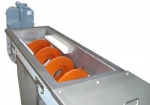Most processes simply can’t be conducted efficiently when relying on manual labour alone. In the solids handling and processing industry, most systems of production and manufacturing will require machinery and specialized conveyor systems, throughout the whole manufacturing process, from storage of raw materials to dispatch from the plant of the finished product.
Screw conveyors are used successfully in many different industries today. Dating back thousands of years, they are still a relatively low-cost piece of equipment, requiring low maintenance in relation to other types of conveying equipment.
They can be specifically designed with a variety of different features to suit each particular application.
We explore why the screw conveyor is such a vital part of industrial production and outline some of the major design types and variations.
What Is a Screw Conveyor?
In its’ simplest form, a screw conveyor is a rotating spiral inside a casing, taking material from the inlet, along the length of the casing, to the discharge point at the end of the casing. Screw conveyors can have U trough casings or tubular casings depending on what the application is.
Advantages of Screw Conveyors
Screw conveyors are capable of handling a great variety of bulk materials from sluggish to free-flowing and can be a smart alternative to a traditional belt conveyor.
They can have multiple inlet and discharge points allowing materials to be conveyed and distributed to various locations as required. Slide valves or gates can be utilized to control the flow into and out of the screw conveyor.
Metering screw feeders are used to convey product from a hopper or bin into the process stream.
They are compact and adaptable to confined spaces and require low headroom. As they are enclosed, the product is contained within the casing so there is little chance of spillage.
Screw conveyors are adaptable in design. They can be horizontal, vertical or inclined to suit the application and product being handled. Typically, tubular screw conveyors are used if the inclined screw conveyor is steeper than 45 degrees.
They can also be designed without a centre pipe. Shaftless screw conveyors or centreless screw conveyors are ideal for conveying wet, sticky sluggish products such as industrial sludges and larger irregular shaped products.
Screw conveyors can be used to mix various products in the process stream, and can also be used as a de-lumper on some products. They have also been used to cool or heat the product being conveyed. The casing can be jacketed and the flight can be mad hollow to provide the necessary heat transfer or cooling.
They can be manufactured in a variety of materials to suit your particular requirements – mils steel, stainless steel, abrasion resistant material.
They can also be designed for easy cleaning – incorporating quick removable covers, drop-bottom casings, and internal spray systems – all to your application.
Learn More
If you’re looking to learn more about U trough screw conveyors, tubular screw conveyors, inclined screw conveyor, vertical screw conveyors or centreless screw conveyors, get in touch with us at Wrights Dowson Group.









